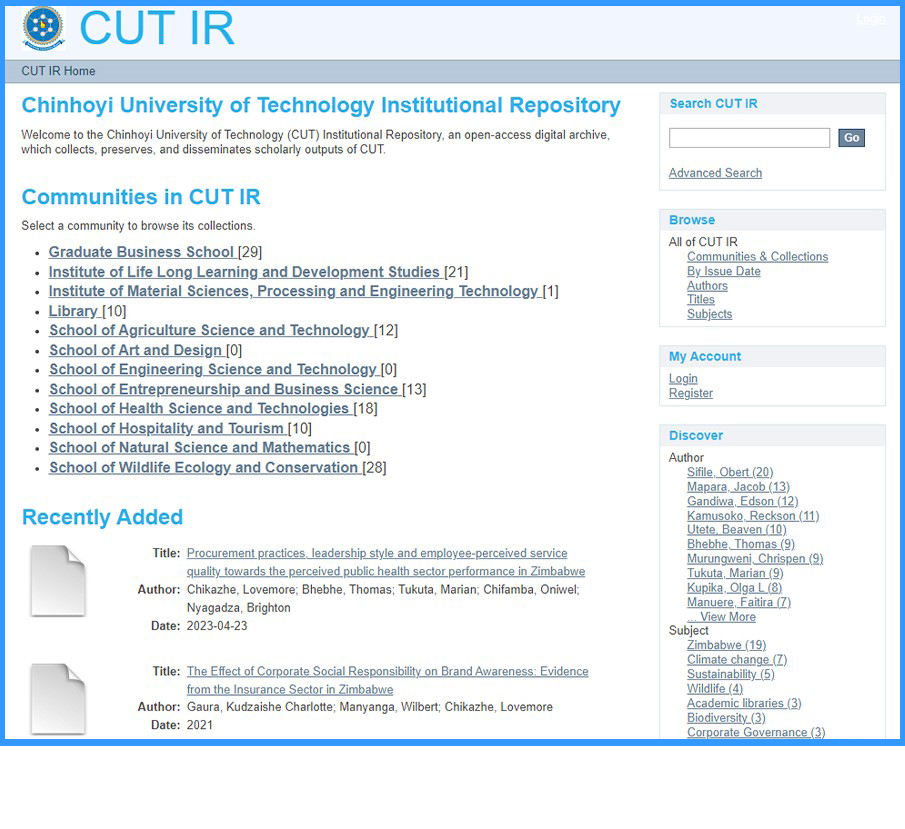Scholary Communication and Publications
Scholarly Communication
Scholarly communication is the process by which scholars create, evaluate, and share the results of their research and creative work.
CUT IR is the open access institutional repository of Chinhoyi University of Technology (CUT). It makes available and digitally preserves the scholarly outputs produced at CUT, including theses and dissertations, journal articles, book chapters, technical and research reports and open educational resources. The repository has been developed in line with international interoperability and metadata standards using DSpace open source software and is indexed by all major search engines.
Visit the IR at https://ir.cut.ac.zw
CUT Journals OnlineCUT Journals Online is the CUT library's online journal hosting service. Visit the CUT Journals Online at https://journals.cut.ac.zw
Copyright and Author Rights
Copyright is a legal protection of an author’s original works of authorship in any tangible medium of expression. It is a form of intellectual property which gives the creator of original work exclusive rights for a certain time period in relation to that work. Exclusive rights include control of publication, distribution and adaptation of the work.
CUT Library offers consultations on copyright and fair use. We are unable to offer you legal advice but can guide you on tools that will help you understand copyright, author’s rights and fair use. The library also offers advice on navigating licensing agreements, retaining and negotiating author rights through author addendums, Creative Commons and other tools.

Predatory Publishing
In recent years, the number of exploitative or deceptive publishers and conferences has grown. These publishers typically send unsolicited invitations to authors offering to publish their research for a substantial fee, however they dont offer any of the traditional services provided by reputable publishers such as editing, peer-review, archiving and marketing.
-
Useful Resources and Guides
- DOAJ is an online directory that indexes and provides access to high quality, open access, peer-reviewed journals.
- COPE focuses on highest standards of publication ethics
- Useful advice from the American Psychological Association (APA)
- This BMJ Blog post by Jocalyn Clark highlights five criteria to check before you submit a publication
- Avoiding Predatory Journals and Questionable Conferences: A Resource Guide. By Sarah Elaine Eaton, University of Calgary, 2018
- Verify this list for your chosen journal to check if it is trusted.
- OASPA Principles of Transparency and Best Practice in Scholarly Publishing Produced by the Committee on Publication Ethics, the Directory of Open Access Journals, the Open Access Scholarly Publishers Association, and the World Association of Medical Editors
The following links contain some useful checklists and examples of questionable publication venues:
-
Directory of Open Access Journals (DOAJ)
Committee on Publication Ethics (COPE)
How to avoid predatory publishers:
How to avoid predatory journals—a five point plan
Predatory Journals, Publishers and Conferences
Avoiding Predatory Journals and Publishers
Think Check Submit Checklist
University of Toronto Libraries Identifying Deceptive Publishers Checklist
Predatory publishing can be a challenging inconvenience for scholars. The Library offers guidance on detecting predatory publishing tactics and how to avoid them.
SPARC Addendum – Use the SPARC author addendum tool when negotiating journal publishing terms. Filling out the addendum and sending it to your publisher helps you retain certain rights to your work.
Creative Commons – Use Creative Commons to license your work how you see fit. Select from a variety of options that allow you to decide if others can use your work for commercial purposes, adapt your work and share it.
- publications and citation metrics
- collaboration metrics
- societal impact metrics
- benchmarking
- Scopus Author ID (developed by Elsevier and used in Scopus and related products).
- ResearcherID(developed by Thomson Reuters and used in Web of Science and related products).
- Google Scholar Author Profile provides a simple way for authors to keep track of citations to their articles. You can check who is citing your publications, graph citations over time, and compute several citation metrics
Scholary Reputation and Impact Services
Research metrics, sometimes called bibliometrics, are often used as a measure of quality or impact of research outputs. There are many different metrics used to measure the influence of journals and understanding their definitions, uses and limitations will help you make decisions about where you publish your research. Knowing the impact of your research can be invaluable when you’re applying for funding, seeking a new position or working towards a promotion.
Metrics can broadly be broken up into 4 categories:Data Sources for Metrics
Scopus (Elsevier) – Abstract and citation database of peer-reviewed literature on fields of science, technology, medicine, social sciences and arts and humanities. Includes books, journals, online tools, bibliographic databases and newsletters. Provides tools to track, analyse and visualise research.
Web of Science (Thomsen Reuters) – Previously known as ISI Web of Knowledge, this database provides a collection of full text and citation index information gathered from scholarly journals, books, book series, reports and conferences.
Google Scholar – Search tool for full text and citations of scholarly literature across many disciplines and sources: articles, theses, books, abstracts and court opinions, from academic publishers, professional societies, online repositories and universities.
Altmetric.com – Provides altmetric data to track and analyse the online activity around scholarly literature.
ORCID – Open Researcher and Contributor ID (ORCID) provides a persistent digital identifier that distinguishes you from other researchers and supports automated linkages between you and your professional activities. Unlike ResearcherID and Scopus Author Identifier, ORCID is not limited by a commercial citation database provider.









